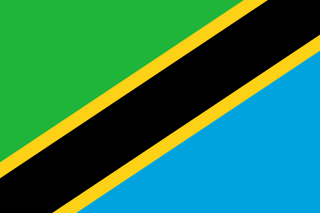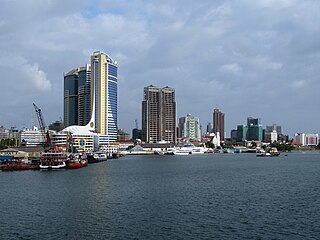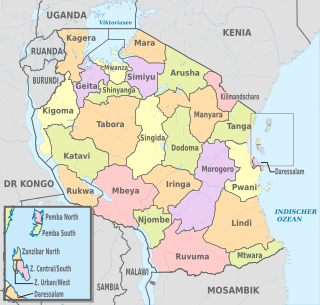
Dar es-Salaam is the largest city and former capital of Tanzania. It is the largest city in East Africa and the seventh-largest in Africa, with a population of 6,701,650. Located on the Swahili coast, Dar es-Salaam is an important economic centre and one of the fastest growing cities in the world.

Tanzania, officially the United Republic of Tanzania, is a country in East Africa within the African Great Lakes region. It borders Uganda to the north; Kenya to the northeast; Comoro Islands and the Indian Ocean to the east; Mozambique and Malawi to the south; Zambia to the southwest; and Rwanda, Burundi, and the Democratic Republic of the Congo to the west. Mount Kilimanjaro, Africa's highest mountain, is in northeastern Tanzania.

This article is about the demographic features of the population of Tanzania, including population density, ethnicity, education level, health of the populace, economic status, religious affiliations, and other aspects of the population.

Tanzania is a low income economy. Tanzania is largely dependent on agriculture for employment, accounting for about half of the employed workforce. The economy has been transitioning from a command economy to a market economy since 1985. Although total GDP has increased since these reforms began, GDP per capita dropped sharply at first, and only exceeded the pre-transition figure in around 2007.
Telecommunications in Tanzania include radio, television, fixed and mobile telephones, and the Internet available in mainland Tanzania and the semiautonomous Zanzibar archipelago.

Zanzibar is a semi-autonomous region of Tanzania. It is composed of the Zanzibar Archipelago in the Indian Ocean, 25–50 kilometres (16–31 mi) off the coast of the mainland, and consists of many small islands and two large ones: Unguja and Pemba Island. The capital is Zanzibar City, located on the island of Unguja. Its historic centre is Stone Town, which is a World Heritage Site.

Tanzania is divided into thirty-one regions or mikoa.

The Ngorongoro Conservation Area is a protected area and a World Heritage Site located 180 km (110 mi) west of Arusha in the Crater Highlands area of Tanzania. The area is named after Ngorongoro Crater, a large volcanic caldera within the area. The conservation area is administered by the Ngorongoro Conservation Area Authority, an arm of the Tanzanian government, and its boundaries follow the boundary of the Ngorongoro Division of the Arusha Region.

Dodoma Region is one of Tanzania's 31 administrative regions. The regional capital is the city of Dodoma. According to the 2012 national census, the region had a population of 2,083,588, which was lower than the pre-census projection of 2,214,657. For 2002-2012, the region's 2.1 percent average annual population growth rate was the twentieth highest in the country. It was also the seventeenth most densely populated region with 50 people per square kilometer. The main tribes of the region are the Gogo, the Warangi, and the Wasandawi; Dodoma means "sunk" in the Gogo language.

Mwanza or Rock city to the residents is a port city on the southern shore of Lake Victoria in north-western Tanzania. With a population of more than 800,000, it is Tanzania's second largest city, after Dar es Salaam. Mwanza is the capital of the surrounding Mwanza Region, and is administratively divided into two municipal districts within that Region - Ilemela and Nyamagana.

Kilimanjaro Region is one of Tanzania's 31 administrative regions with a postcode number 25000. The regional capital is the municipality of Moshi. According to the 2012 national census, the region had a population of 1,640,087, which was lower than the pre-census projection of 1,702,207. For 2002-2012, the region's 1.8 percent average annual population growth rate was the 24th highest in the country. It was also the eighth most densely populated region with 124 people per square kilometer.

Manyara Region is one of Tanzania's 31 administrative regions. The regional capital is the town of Babati. According to the 2012 national census, the region had a population of 1,425,131, which was lower than the pre-census projection of 1,497,555. For 2002-2012, the region's 3.2 percent average annual population growth rate was tied for the third highest in the country. It was also the 22nd most densely populated region with 32 people per square kilometre.

Iringa is one of Tanzania's 31 administrative regions. The regional capital is Iringa. The region's population is 941,238. It is primarily agricultural and boasts the second-highest per-capita GDP in the country.

Kigoma Region is one of Tanzania's 31 administrative regions. The regional capital is the city of Kigoma. According to the 2012 national census, the region had a population of 2,127,930, which was higher than the pre-census projection of 1,971,332. For 2002-2012, the region's 2.4 percent average annual population growth rate was tied for the fourteenth highest in the country. It was also the sixteenth most densely populated region with 57 people per square kilometer. With a size of 45,066 square kilometres (17,400 sq mi), the region is slightly smaller than Estonia.

Mwanza Region is one of Tanzania's 31 administrative regions with a postcode number 33000. The regional capital is Mwanza.

Tanga Region is one of the 31 administrative regions of Tanzania. It is bordered by Kenya and Kilimanjaro Region to the north; Manyara Region to the west; and Morogoro and Pwani regions to the south. Its eastern border is formed by the Indian Ocean. It has a population of about two million.

Unguja is the largest and most populated island of the Zanzibar archipelago, in Tanzania.

Christianity is the largest religion in Tanzania according to the most recent estimates. There are also substantial Muslim and Animist minorities.
There were Chinese people in Tanzania as early as 1891. However, most of the Chinese in the country trace their roots to three distinct waves of migration: 1930s settlement on Zanzibar, workers sent by the Chinese government in the 1960s and 1970s as part of development assistance to Tanzania, and private entrepreneurs and traders who began doing business there during the 1990s.

Simiyu Region is one of Tanzania's 31 administrative regions. The regional capital is the town of Bariadi. The region was created in March 2012, from part of Shinyanga Region.
















